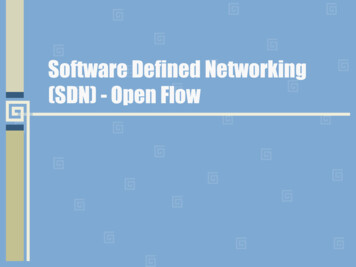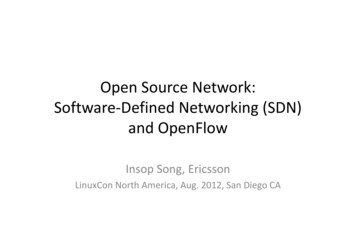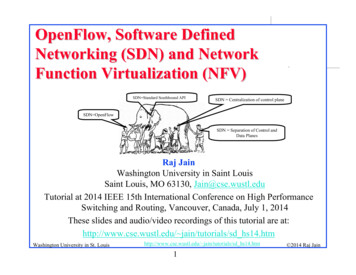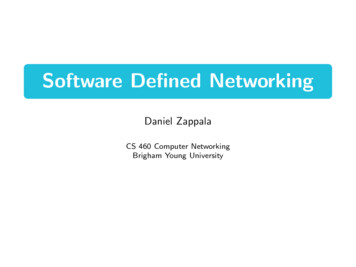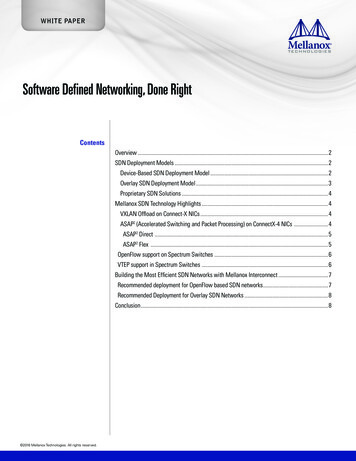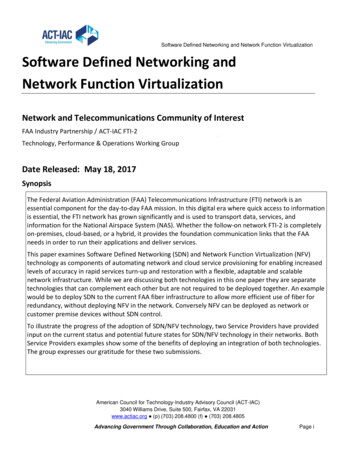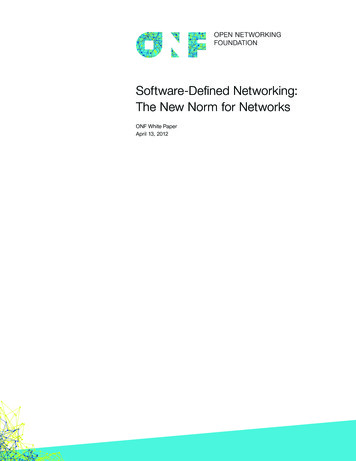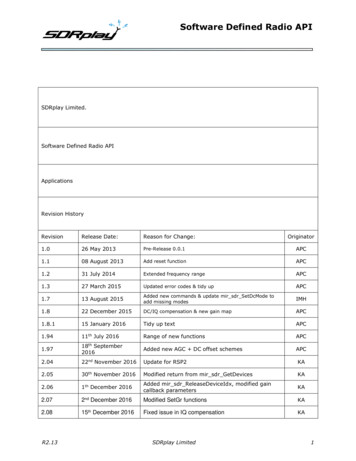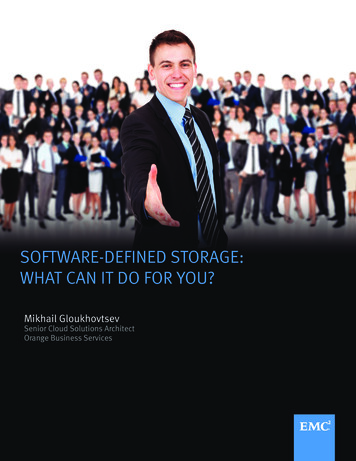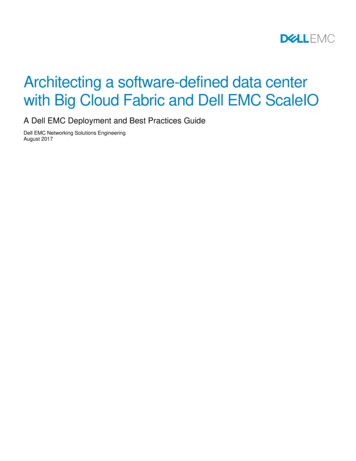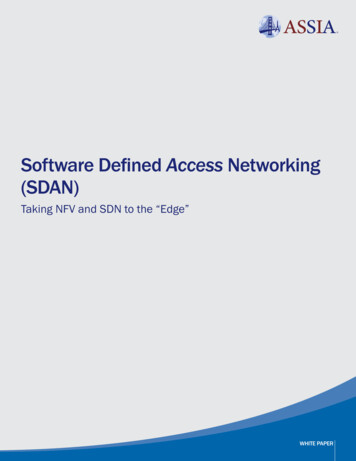
Transcription
Software Defined Access Networking(SDAN)Taking NFV and SDN to the “Edge”WHITE PAPER
White PaperContentsExecutive Summary3Introduction31.1. Access Networks31.2. SDN and NFV41.3. Three Scenarios for Software-Defined Access Networking42. Single Operator SDAN52.1. Access Network Control52.1.1. Traditional Access Network Control52.1.2. SDAN Control52.2. Access Network Diagnostics62.2.1. Traditional Access Network Diagnostics72.2.2. SDAN Diagnostics and Recommendations73. Multiple Operator SDAN73.1. Access Network Sharing73.1.1. Traditional Access Network Sharing83.1.2. SDAN Network Sharing83.2. Configuration, Diagnostics and Remediation Functions for Shared Access Plants93.2.1. Traditional Functions for Shared Access Plants93.2.2. Multi-Tenant Platform for Shared Access Plants104. SDAN to the Home124.1. Traditional Management of the Broadband End-User Experience124.2. Improved Management of the Broadband End-User Experience with SDAN125. Recommendations for Network Operators13References15Acronyms and Abbreviations15Software Defined Access Networking (SDAN) 2
White PaperExecutive SummaryExtending the benefits of Network FunctionsVirtualization (NFV) and Software-Defined Networkingto the edge of the network, including access segmentsand subscriber premises, offers enormous gains inflexibility and control of broadband access services. Thisconcept is described here as “Software Defined AccessNetworking” or SDAN.SDAN virtualizes access-network control andmanagement functions for broadband access, with thegoal of streamlining operations, accelerating servicecreation, enhancing performance, enabling competitionamong service providers on a shared infrastructure,and ultimately enhancing customer satisfaction withbroadband access.Although this paper focuses principally on DSL accesstechnology, SDAN includes any type of broadbandaccess: digital subscriber lines (DSL), cable modems,fiber-to-the-x (FTTx), wireless, and so on. Virtualizationand control of the in-home network also is within therealm of the SDAN. An integral aspect of SDAN is thatunlike traditional SDN, advanced management andcontrol down to the PHY level are highly desirable andincluded features.This paper presents three network scenarios representingprogressive levels of SDAN:1. A single entity operates the physical accessinfrastructure and sells access services enabled bythat infrastructure to end-users. This entity is thus aphysical infrastructure provider (PIP) and a networkoperator. By centralizing access network control,diagnostics and analytics, the provider can greatlyimprove operational efficiencies and expand revenueopportunities. Such practices are already applied ontens of millions of DSLs worldwide.2. A PIP manages a single physical infrastructure overwhich multiple virtual network operators (VNOs) offerend-user services. This scenario includes bit-streamaccess and variants such as virtual unbundled localaccess (VULA) services. SDAN virtualizes the networkequipment to enable VNOs to realize a level of flexibility1 A Physical Infrastructure Provider (PIP) differs from the concept ofan Infrastructure provider in network function virtualization (NFV)terminology [2][3]. In NFV literature, an infrastructure provider isthe provider of the compute, storage and network hardware resourcesthat constitute the execution environment for virtual networkfunctions (VNFs).and a level of efficiency which is the same as owningand directly controlling the equipment, while providingfor determinacy in the management and performanceof the shared, underlying physical network.3. PIPs and VNOs have access to data regardingconsumer experience and broadband performance,which is made available from platforms monitoringend-user devices, services and customer premisesnetworking technology. This additional data isused to better monitor access services and tuneperformances to meet end-user needs, which expandsthe VNOs’ abilities to improve customer experienceand offer new types of services.IntroductionThis section gives a brief introduction to accessnetworks, and to SDN and NFV concepts. It alsoprovides a high-level explanation of the three scenariosfor SDAN. For more details on industry drivers thatlead to the introduction of the new SDAN concept, seethe IEEE Communications Magazine article “SoftwareDefined Access Networks[1].”1.1. Access NetworksInternet service is delivered to residential consumersthrough the access network (also known as the “lastmile” connection). Regardless of the transmissionmedium, access networks contain three fundamentalparts: access nodes on the infrastructure side, residentialgateways on the consumer side, and the (typicallypassive) outside plant that connects the two sides.In DSL networks, the access node is called a DSLaccess multiplexer (DSLAM); in fiber networks, it iscalled optical line terminal (OLT); and in coaxial-cablenetworks, it is called a cable modem termination system(CMTS). The access nodes are connected to the corenetwork through aggregation networks. The residentialgateways are connected to consumer devices through thehome network.In some DSL markets that have regulatory requirementsfor unbundling, multiple entities are involved in thedelivery of Internet services. As shown in Figure 1, thecopper cable may be owned by a metallic path provider,the access nodes and the aggregation network may becontrolled by an access node provider, and the home andbroadband networks may be in the control of a VNO. Inmost markets, the metallic path provider and theSoftware Defined Access Networking (SDAN) 3
White PaperVirtual Network OperatorAccess Node ProviderMetallic Path ProviderVirtual Network OperatorFigure 1: DSL network example with multiple entities controlling different segmentsaccess node provider are the same entity, which this paperdefines as the physical infrastructure provider1 (PIP).The separation of the PIP from the VNO started withDSL networks, but it is technically possible and is gainingground for fiber and coaxial-cable networks. Here aresome noteworthy related developments: Discussions among UK providers for a joint venturefor building fiber infrastructure [4]. Standards proposals for fiber network virtualization [5]. Research efforts into economics of fiber infrastructuresharing [6]. Efforts by the Belgian telecommunications regulator topromote competition over the cable infrastructure [7]. Strategic decision of NBN-Co to use hybrid-fiber-coax(HFC) infrastructure to deliver fast-broadband toAustralian retail service providers [8].1.2. SDN and NFVSDN is generating a wave of interest as a technologythat makes networks programmable and less expensiveto build, operate, and upgrade. It is typically describedas separating the control and the data forwardingfunctions of network equipment, and centralizingthe control functions of multiple network elements.More generally, SDN is a framework for automatic anddynamic management of multiple network elements.So far, SDN control has referred to functions above thephysical layer—such as packet forwarding—and in thecore network.telecom world, and today is being looked at with growinginterest. NFV leverages virtualization technology toconsolidate network equipment using commercial-offthe-shelf servers and storage located in data-centers,network centers, and possibly also at user premises.This is expected to lead to reduced equipment costs byreducing requirements for purpose-specific hardware.Furthermore, network and service features defined insoftware will allow rapid changes in service definitionsand sharing of hardware components.Network functions migrate from embedded firmwarein the dedicated hardware of various broadband accessnetwork appliances to software running on commodityhardware in a private or public cloud. These virtualizednetwork functions run in a standardized executionenvironment thus eliminating the dependency betweena network function and its dedicated and vendor-specifichardware. In some cases, it is not possible to completelyeliminate hardware dependency. This is the case whennetwork functions are only partially virtualized, and mayoccur when complex signal processing must run locallyin real time, or when interfaces between the analog anddigital worlds are present. However, even if there arefunctionalities that are not easily virtualized, it is stillpossible to eliminate the dependency on vendor-specifichardware by using open interfaces and appropriateabstraction layers for the underlying hardware.1.3. Three Scenarios for Software-Defined AccessNetworkingThis paper presents three access network scenarios, withprogressive degrees of virtualization. These three scenarioscorrespond to three possible instantiations of a SDAN.NFV brings many of the virtualization conceptsdeveloped for enterprises and data centers into theSoftware Defined Access Networking (SDAN) 4
White PaperThe first scenario is that of a network owned by a singleoperator, where a single entity serves as PIP, i.e. controllingthe outside plant and the access hardware, and also as anetwork operator, i.e. providing services to consumers.This scenario is representative of many current networksin which there is no virtualization of the access network.In this scenario, a management system centrally controlsand manages all lines connected to the access hardware.Control functions include the optimization of the physicallayer configuration of the broadband connection, forexample changing parameters such as data rates andpower levels. Management functions include networkanalytics that drive maintenance operations and marketingcampaigns. Centralizing these functions enables the useof advanced algorithms delivering the highest gains,and it also allows for homogeneous, vendor-agnosticmanagement of the access hardware.Next, a scenario in which multiple VNOs deliver servicesto end-users over a single infrastructure is considered.The outside plant and the access hardware are controlledby one or more PIPs, who may themselves be VNOs. Thisscenario applies to current networks where regulatoryprovisions for competition via local-loop-unbundling(LLU), sub-loop-unbundling (SLU) or bit-stream accessexist2. This scenario is especially common in regionswith facilities-based competition or where Layer 2competition is mandated by regulators. In this case, amulti-tenant management system enables the VNO tomaintain substantial control of services, while providingfor determinacy in the operation and performance of theunderlying physical network.Finally, the third scenario is a complete softwaredefined access network that extends beyond the accesssegment, and includes the in-home network and possiblyapplication platforms. In this case, a cloud-based systemreceives data on end-to-end broadband access andapplication performance. The data is collected by agentsin the network, and is used to guide the optimizationand diagnostics engines of the broadband network’smanagement system.2. Single Operator SDANThis section describes the first SDAN scenario. Typicallyin this scenario, a single entity serves both as the PIP(controlling the outside plant and the access hardware)and as the VNO providing services to consumers.2.1. Access Network ControlAccess network control is necessary for configuring theaccess network to support the delivery of broadbandservices to consumers. Configuration changes areapplied to the access nodes, which affect physical layerconfiguration parameters such as data rates, transmittedpower and spectrum, coding schemes, resilience tonoise, and latency. For DSL, a predefined set of suchconfiguration parameters is called a profile.2.1.1. Traditional Access Network ControlTraditional access network control relies on the use ofdefault profiles. These profiles, also known as goldenprofiles, have a one to one correspondence with a serviceproduct, and they are applied to all newly provisionedlines with a given service product. However, there isvast diversity in the transmission characteristics oflines in the access network, either because of the noiseenvironment (e.g. interference in the home and outsideplant), or because of the transmission medium (e.g.variation in the quality of the channel, differences in linelengths, bad contacts or splices, and imperfections ofthe copper or fiber). The application of a golden profileto such a mixed population of lines results in poorperformance for a substantial portion of these lines.The traditional remedy to the limitations of using goldenprofiles is the introduction of maintenance profiles. Suchmaintenance profiles are applied to lines that are foundto suffer from poor performance. This typically occursin reaction to customer complaints, or as technicianswork to correct issues in the field. This means that amaintenance profile is applied only after the customerhas experienced a poor service, and after the providerhas incurred significant customer support expenses.Finally, the manual application of maintenance profilesgreatly complicates the enforcement of a network-wideprofile policy. Contact center agents and technicianscan be inconsistent in following established guidelines,or follow their own preferred practices. As a result,maintenance profiles are improperly or inconsistentlyused in the network. This weakens the enforcementof a network-wide profile policy, and results in poorcustomer experience and higher operational costs.2.1.2. SDAN ControlThe modern approach for access network controlincludes the use of software-based profile optimization.Each service product is assigned a set of allowed2 In the case of bit-stream access, VNOs are often called resellers.Software Defined Access Networking (SDAN) 5
White Paperprofiles3, and software applies to every line in the networkthe profile for that line’s service product that best matchesthe line’s specific transmission characteristics. Thesoftware algorithms performing this profile optimizationrely on historical and current data about the line,and account for the line’s service product. The profileoptimization process is performed for newly provisionedlines, and for lines that are performing poorly or belowtheir full potential. Mutually interfering lines are alsooptimized for improved coexistence4. In this way, theaccess network is automatically and continuouslyadapting to evolving conditions without requiringmanual intervention. Additionally, profile optimizationcan be invoked in real time by contact center agents orby technicians. The principle of profile optimization isillustrated on the right-hand side of Figure 2.The above methodology ensures that all profile changesin the network follow a set of rules established by theoperator and are embedded in the configuration of theprofile optimization software. As a result, software-based profile optimization enables centralized policymanagement for access. The operator controls howresources are allocated to obtain the desired outcomesin terms of service reliability, throughput rates, powerconsumption, and network crosstalk (specifically forDSL). The operator has freedom to define a diversefamily of service products (thus increasing consumerchoice), and to apply on each line the optimal policy foreach such product.This practice of SDAN control has strong similaritieswith the fundamental principles of SDN. SDN separatesthe data plane from the control plane for routing andswitching equipment. The control plane is then logicallycentralized and made programmable. Applicationsinterface only with the control plane, and are notconcerned with the forwarding elements that comprisethe data plane. Similarly, SDAN control separates thedata transmission layer from the control layer. Thecontrol layer contains the logically centralized softwarethat implements the operator’s policy. The policy isFigure 2: Software-defined Diagnostics (left-hand side) and Profile Optimization (right-hand side)3 Older equipment limits the number of profiles that can be stored toas few as 40. Newer equipment allows much larger numbers of profiles,and allows the definition of sub-profiles for even higher flexibility.4 The process of joint optimization of profiles of multiple lines is calledvector profile optimization. It applies to mutually interfering DSLs, butalso to shared media such as GPON and coaxial cable access systems.Software Defined Access Networking (SDAN) 6
White Paperapplied homogeneously to the entire access network,which can include any mix of access equipment frommultiple vendors.rely on hardware, they are difficult to enhance, and theyare isolated from other network functions.2.2. Access Network DiagnosticsThe modern alternative to traditional access networkdiagnostics is the migration of analysis functionality toserver infrastructure, while keeping only the necessaryraw test-data capture functionality on the access node(or on specialized test hardware). The advantages of thisapproach are explained below.Access network diagnostics is the analysis of data collectedfrom the access network for resolving service issues,for qualifying customers for services, and for planningnetwork maintenance and upgrades. Data are collectedfrom the access nodes, and may additionally be collectedfrom test equipment connected to the outside plant (forexample, specialized hardware for DSL metallic testing, orfor optical time-domain reflectometry (OTDR)).2.2.1. Traditional Access Network DiagnosticsTraditional access network diagnostics rely heavilyon hardware systems, for example on specialized testheads for DSL metallic testing, or on handheld devicescarried by technicians. Such hardware systems havehigh costs for deploying and for operating, and oftenrequire replacement or expensive upgrade programs forsupporting newer generations of access technology. Theyare used for performing invasive tests, which typicallycause service disruption, and must therefore include theprior consent of the affected customer.More recently, access equipment manufacturers havebuilt access nodes that integrate data transmissionfunctionality with testing capabilities (e.g. metallic looptesting (MELT), and single-ended loop testing (SELT),in DSL; or OTDR in GPON). But the results delivered bysuch equipment are still physical media diagnostics withlimitations similar to those of specialized test hardware.The use of isolated diagnostics data from specializedtest hardware or from access nodes is problematic inseveral ways:a. Data from a test performed at a given time may fail toidentify intermittent issues.b. Results from one type of test cannot be combinedwith other results to improve accuracy andconfidence.c. Results cannot take into account the “context” ofthe connection, for example, whether a line fault isperformance-affecting for the current service product,such as Internet access or IPTV.2.2.2. SDAN Diagnostics and RecommendationsSDAN-based diagnostics enable the combined use of rawtest-data from multiple sources. For instance, data canbe combined from sources such as access nodes, servicemanagement platforms, and specialized hardware.Also, different types of test data can be combined, e.g.SELT, MELT and Double-Ended Loop Testing (DELT)data in DSL. Finally, the analysis can take into accounthistorical data to better analyze time-varying effects. Theend results are improved accuracy for diagnostics andimproved identification of the root causes of degradation.A software-based framework allows for the expansionof diagnostics functionality for further inclusion inrecommendation functions. Recommendations mayinclude the identification of upsell opportunities, basedon analysis of the following:a. the current service of a consumer,b. the capacity of the line for a higher-tier service, andc. the historical broadband usage of the connection.Other types of recommendations or analytics can includethe identification of customers with high risk for churn,or the prioritization of certain areas for proactive outsideplant maintenance. All of the above fun
WHITE PAPER Software Defined Access Networking (SDAN)2 Contents Executive Summary 3 Introduction 3 1.1. Access Networks 3 1.2. SDN and NFV 4 1.3. Three Scenarios for Software-Defined Access Networking 4 2. Single Operator SDAN 5 2.1. Access Network Control 5 2.1.1. Traditional Access Networ
